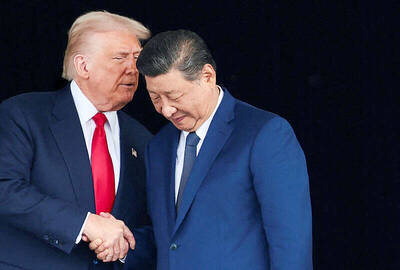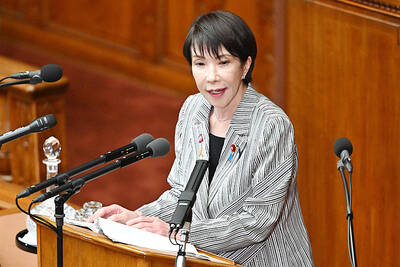Radioactive dust from Japan’s Fukushima Dai-ichi nuclear power plant could come close to Taiwan tomorrow, but radiation levels will remain “very low” and be of no risk to human health, the Atomic Energy Council said yesterday.
In its presentation, the council said it had used weather information provided by the Central Weather Bureau (CWB) from yesterday until Friday to estimate the impact of the radioactive dust on Taiwan.
One of the wind forecast models showed that the radioactive dust would approach the nation between tomorrow and Friday, it said.
“On Friday, the dust will come within 200km of the nation’s northeast coast, which will be the closest it gets,” the council said.
For Thursday, the council forecast that the maximum impact of the radioactive dust on the nation would be 0.0223 microsieverts per hour, which remained lower than the natural background value of 0.1 microsieverts per hour, it said.
The amount of radiation in the dust does not pose a health risk because it would take the human body 1,000 hours of being battered by the cloud of fallout to absorb the same radiation as a single chest X-ray, the council said.
The Government Information Office yesterday also said that radioactive dust would only come within about 200km of Taiwan at its closest over the next few days.
The council said calculations for the maximum impact of radiation fallout from Fukushima Dai-ichi were based on specific criteria — radiation levels at the plant must reach 78.4 microsieverts per hour, the emission of radioactive dusts must be continuous and the dust must also be blown directly toward Taiwan.
Meanwhile, in a markedly different assessment, Academia Sinica said the radioactive dust could arrive on the nation’s east coast today, albeit in a highly diluted form.
Liu Shaw-chen (劉紹臣), director of Academia Sinica’s Research Center for Environmental Change, said radiation within 20km of the plant had dropped to an average of 1 to 2 microsieverts per hour on Sunday.
“If the average radiation level of the dust is 1.5 microsieverts, it would potentially be diluted 100 times to 0.015 microsierverts [by the time it reached Taiwan],” Liu said.
Liu said radioactive dust would be carried to Taiwan via the northeast monsoon, which could bring rain to mountainous areas along the east coast. Radiation levels in the rain could be between 10 and 100 times higher than 0.015 microsieverts, he said.
Residents in these areas are advised to carry umbrellas and raincoats to avoid contact with radioactive fallout, he said.
So far, no abnormal levels of radiation have been detected in sea areas around northern Taiwan since the council began working with the Coast Guard Administration on March 18 to send two vessels out daily to check radiation levels. The ships have traveled as far as 630km away from the Port of Keelung.
ADDITIONAL REPORTING BY CNA

Taiwan’s exports soared to an all-time high of US$61.8 billion last month, surging 49.7 percent from a year earlier, as the global frenzy for artificial intelligence (AI) applications and new consumer electronics powered shipments of high-tech goods, the Ministry of Finance said yesterday. It was the first time exports had exceeded the US$60 billion mark, fueled by the global boom in AI development that has significantly boosted Taiwanese companies across the international supply chain, Department of Statistics Director-General Beatrice Tsai (蔡美娜) told a media briefing. “There is a consensus among major AI players that the upcycle is still in its early stage,”

The Central Weather Administration (CWA) yesterday said it expected to issue a sea warning for Typhoon Fung-Wong tomorrow, which it said would possibly make landfall near central Taiwan. As of 2am yesterday, Fung-Wong was about 1,760km southeast of Oluanpi (鵝鑾鼻), Taiwan’s southernmost point, moving west-northwest at 26kph. It is forecast to reach Luzon in the northern Philippines by tomorrow, the CWA said. After entering the South China Sea, Typhoon Fung-Wong is likely to turn northward toward Taiwan, CWA forecaster Chang Chun-yao (張峻堯) said, adding that it would likely make landfall near central Taiwan. The CWA expects to issue a land

‘SECRETS’: While saying China would not attack during his presidency, Donald Trump declined to say how Washington would respond if Beijing were to take military action US President Donald Trump said that China would not take military action against Taiwan while he is president, as the Chinese leaders “know the consequences.” Trump made the statement during an interview on CBS’ 60 Minutes program that aired on Sunday, a few days after his meeting with Chinese President Xi Jinping (習近平) in South Korea. “He [Xi] has openly said, and his people have openly said at meetings, ‘we would never do anything while President Trump is president,’ because they know the consequences,” Trump said in the interview. However, he repeatedly declined to say exactly how Washington would respond in

Japanese Prime Minister Sanae Takaichi said yesterday that China using armed force against Taiwan could constitute a "survival-threatening situation" for Japan, allowing the country to mobilize the Japanese armed forces under its security laws. Takaichi made the remarks during a parliamentary session yesterday while responding to a question about whether a "Taiwan contingency" involving a Chinese naval blockade would qualify as a "survival-threatening situation" for Japan, according to a report by Japan’s Asahi Shimbun. "If warships are used and other armed actions are involved, I believe this could constitute a survival- threatening